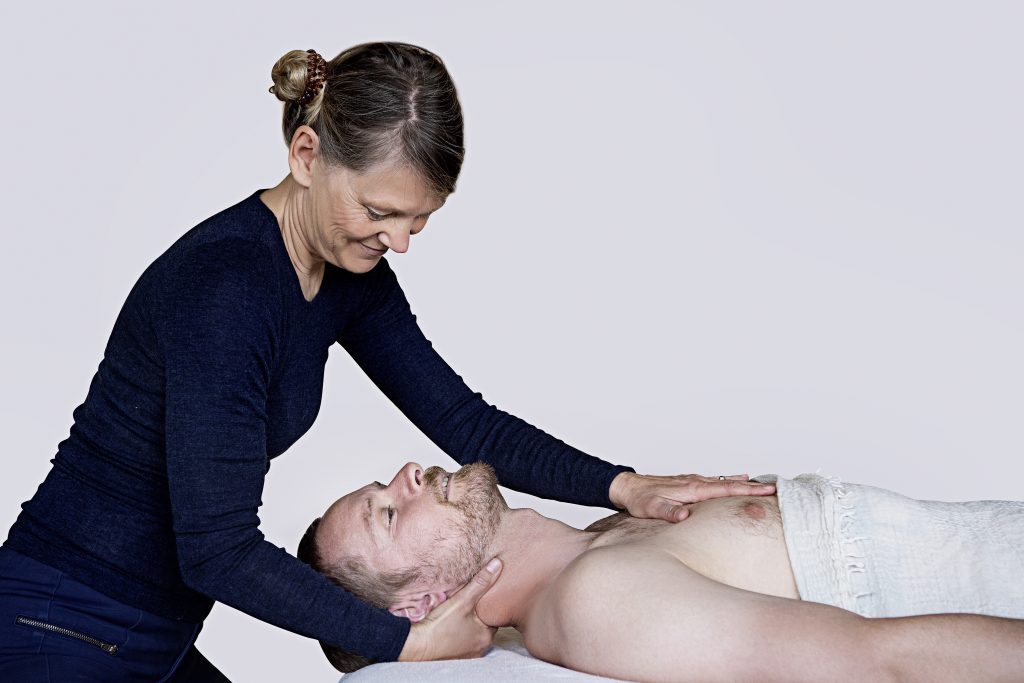
What is Body Therapy?
Manuvision body therapy can help with a broad spectrum of physical and mental disorders, which can stem from many different things such as occupational injuries, physiological imbalances and mental states derived from stress, shock or trauma.
As therapists we believe the body has an inherent capacity to heal itself.
Our role is to assist this process.
Manuvision Body Therapy aims to re-balance the nervous system and the connection between body, mind and emotion.
The body reflects everything which happens to it – whether on an unconscious or conscious level, or whether of an instinctive, emotional or intellectual nature. Any communication with this body – a touch, a vibration, or a word – will reverberate on all levels.
Everything in us is linked. If we experience a change in the breathing, there is also bound to be a change in our muscular tensions, our facial expression, our posture, and even how we think and experience ourselves.
This is also reflected on an unconscious level. All the systems in our body, the skeletal, muscular, nervous, endocrine, cardiovascular, lymphatic, respiratory, digestive, urinary, and the reproductive system are linked. If the nervous system experiences that we are under a threat all the other systems will respond accordingly. If the autonomic nervous system goes into a so-called ‘fight or flight’ mode, the muscles tense up, adrenalin is released, we get angry or afraid, the heart starts pounding, our breathing changes, the digestion stops and so on.
If one or more of these systems are compromised in any way, it will affect the others.
If I have digestive problems, the cause might be that I am worrying about something.
When we are experiencing pain – whether it is of a physical, emotional or mental nature – Manuvision looks at it as a means of communication. There is something we need to listen to.
What is this amazing body trying to tell us?
We need to learn to listen to what the body communicates, to ‘see’ the body’s form of expression.
All our past experiences are stored in the body. We might have forgotten them, but the body remembers, and it never lies.
One of these experiences, or several of them, which initially put our body in a state of alert, might still be doing so even if the original cause of this alert has passed. At some point the body cannot maintain this level of tension anymore and we start feeling pain, often headache, shoulders, back, lower back, knees, joints, anxiety, stress, or, if the pressure on our system is too much or has lasted too long, our system starts shutting down, resulting in low energy, depression, digestive problems, infections, lack of social contact and so on.
The body does this to protect us, there is nothing wrong with us.
If we can accept that our pains are trying to tell us something and that they are related to our body trying to protect us, we are already a long way. Pain can sometimes be looked at as being a consequence of our autonomic nervous system overprotecting us. It can bring us unnecessarily into a state of ‘fight or flight’ or cause a ‘shutting down’.
The deeper we can relate to our body as it is, the more the nervous system can relax. It is ‘seen’ if you like. Listened to. When the autonomic nervous system relaxes all the other systems relaxes too, and, in the example given above, we are not in a ‘fight or flight’ mode any longer, and the digestion can start working again.
When our bodily systems are more relaxed the memories which are stored, there can start to flow. This can help me to find the cause of my discomfort if I don’t already know it and can help me to change my relationship with these causes. We might experience traumas that will stay with us forever, but our relationship with them can change – and so can the impact they have on our health.
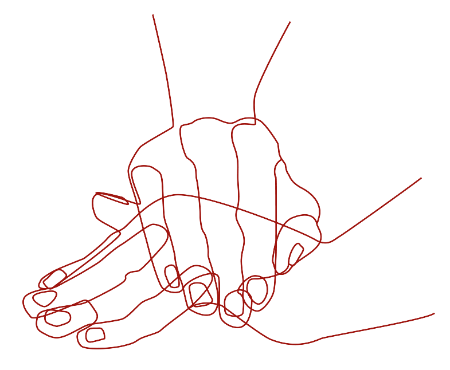
Healing and the autonomic nervous system
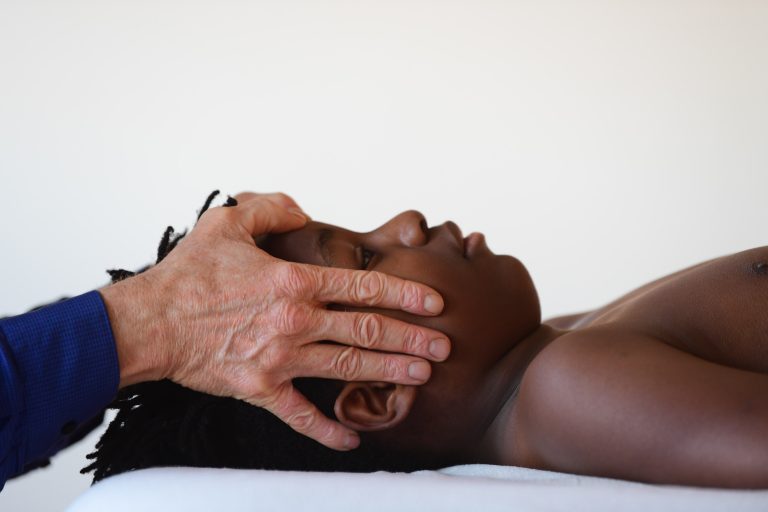
The autonomic nervous system (ANS) is part of the peripheral nervous system and plays an important part in the way the nervous system responds to our feeling of being safe.
The Autonomic Nervous System is intimately linked with all the other systems in our body. If anything in any of the systems starts working improperly the ANS will respond accordingly and activate the required systems (auto-immune, endocrine, cardio-vascular, lymph, blood circulation etc). All pains are reflected in the way the ANS functions and rebalancing a dysfunctional ANS will have a beneficial effect on all the other systems, and on the feeling I have of myself.
Traditionally the autonomic nervous system is considered to consist of two antagonistic parts: the sympathetic (‘fight and flight’), and the parasympathetic (‘rest and digest’). This approach is not always helpful in understanding less obvious disorders such as depression, or why some people cannot even feel pain, or feel life.
The Polyvagal Theory is a relatively new and very different approach towards understanding how our autonomic nervous system works.
Manuvision uses the knowledge and understanding provided by The Polyvagal Theory.
We find that The Polyvagal Theory provides some very helpful and interesting approaches to how our inherent healing forces function, and what the consequences may be if they are impaired.
Almost all disorders have a cause which has very interesting links to how the Autonomic Nervous System (ANS) operates and to how it might become dysfunctional.
It all boils down to the fact that our body is doing everything it can to protect us, including healing us.
If we feel safe, we are situated in a part of the ANS which the Polyvagal Theory calls either Social Engagement, Mobilisation Without Fear, (the mobilisation needed to make a cup of tea, for example) or Immobilisation Without Fear (chilling out or meditating, for example).
If we feel unsafe the ANS goes into either Mobilisation By Fear (‘fight or flight’) – or into Immobilisation By Fear – (‘shutting down’).
In the event of receiving a shock – such as a fall, breaking a leg, a car accident, being hit by someone, exposed to any kind of abuse – which is not ‘shaken out’ of the system after the danger has passed – it might cause the ANS to become dysfunctional, or as we sometimes say become traumatised (we use the word for anything which is too much/overwhelming).
The result can be that the ANS becomes either hypo- or hypersensitive to the surrounding conditions in the sense of experiencing them as dangerous.
Let’s say that you enjoy driving, you like the quietness, you feel safe and calm, and then out of the blue you are hit by another car! You are lucky, no serious physical damage to your body, but after a while – perhaps even years – you start experiencing headaches, your digestion malfunctions, and you start feeling depressed.
What might be the cause is that the accident could have caused you to go into Immobilisation By Fear, and no one brought you back from the fear, the consequence being that you’ve stayed there, or that Immobilisation By Fear is activated whenever you normally would feel safe (like in the car). Even places where you normally feel safe, like your home, might bring on the experience of depression.
If our natural way of experiencing whether something is safe or not is impaired our nervous system can be Mobilised By Fear without any apparent reason. This mobilisation will also mobilise other systems in our body and if this has been going on for some time it can be the cause of multiple disorders – anxiety, depression, eczema, psoriasis, hyper auto-immune system, arthritis, headaches, migraine, hypersensitive skin, irregular heartbeat, heart palpitation, bowel problems and much more.
If the experience of not feeling safe is overwhelming either due to a single incident or repetitive incidents it can cause the autonomic nervous system to shut down – to protect us. Disorders arising from this kind of exposure can be depression, self-harming, suicidal thoughts, fatigue, social isolation and many others.
Knowledge New and Old

The Manuvision Body Therapy is founded on both traditional knowledge as well as recent research and discoveries.
A key concern of a Manuvision treatment is helping an unbalanced or traumatised nervous system to come back to its ‘default’ position.
To this end we are using the insights provided by Polyvagal Theory as mentioned before. This tool gives a very strong platform for seeing and understanding the connections between many disorders, and a dysfunctional autonomic nervous system. It also gives a very strong tool for re-establishing a normal and healthy response to what life brings. Polyvagal Theory gives us a platform with the help of which we are able better to communicate with the unconscious, the autonomic parts of our nervous system. We can see which part of the autonomic nervous system the client is situated in and can apply different techniques to make changes.
The Manuvision therapists use a range of well-established techniques to this end and to release tensions in joints, tendons, ligaments, muscles and to assist a good circulation and flow in the body.
We also recognise the influence Meditation has in relation to health, to the individual’s experience of self, and to reuniting with one’s inner strength.
A Manuvision therapist practices meditation to be able to recognise a quiet place inside her or himself from where the client can be seen, allowing a non-invasive empathetic treatment to take place.
Techniques
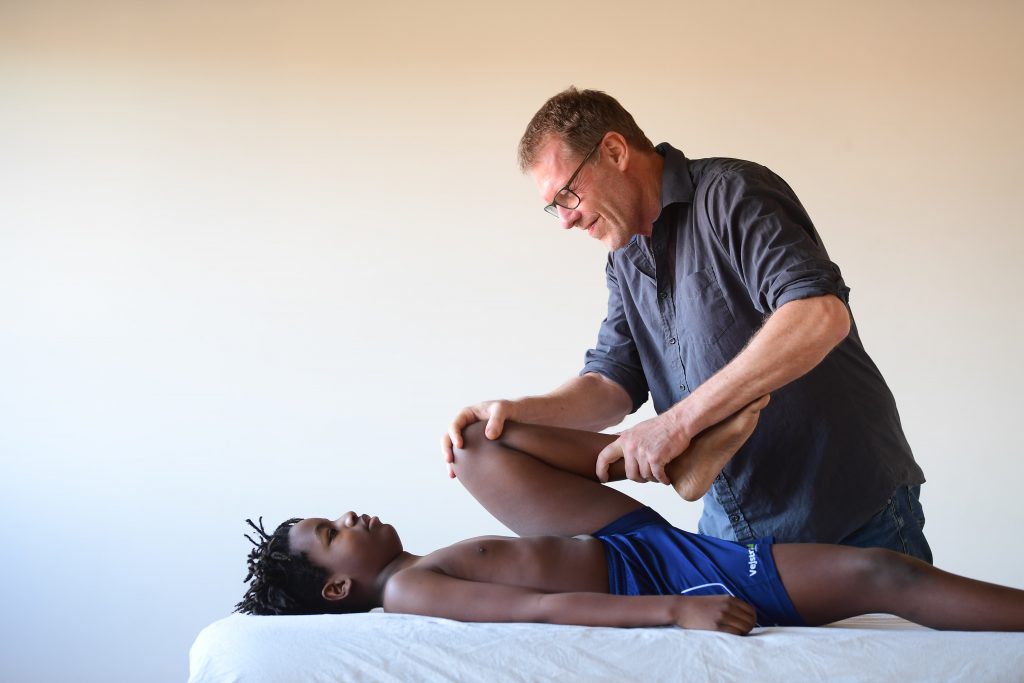
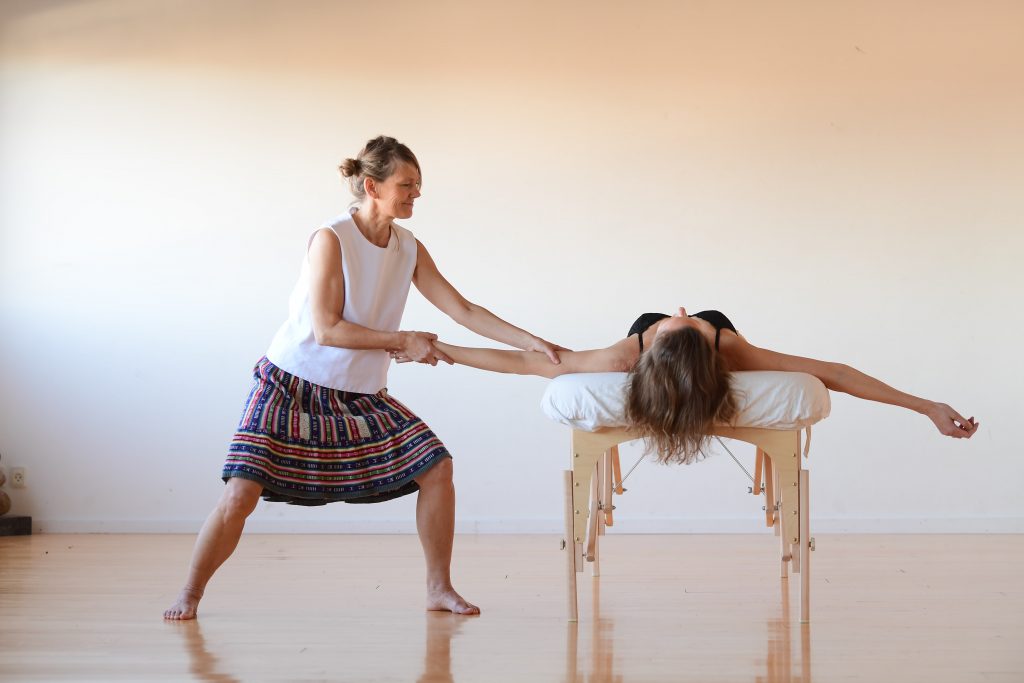
The most important ‘technique’ in a Manuvision treatment is empathy.
This is the particular quality of the relationship between the client and the therapist, and specifically the quality with which the therapist applies a pressure with his hands to a particular part of the body.
One could say the therapist applies a gentle pressure and listens at the same time.
This alone has a huge positive impact on balancing the client’s nervous system.
Another ‘technique’ is seeing pain as a two-way means of communication.
Pain or dysfunction – physical, emotional, or mental – can in many cases be seen as a way our body and mind are telling us that something needs to be attended to, a bottom-up communication if you like, and one way to attend to it can often be to meet this pain where it expresses itself via the body. The therapist will apply a pressure which can be uncomfortable but only so much that the client can relax into it without going into a ‘fight or flight’ mode or without ‘disappearing’. What we often describe as a ‘good pain’.
In such a way a communication between the Social Engagement system (see above) and the dysfunctional or traumatised part is established. This connection, this communication can positively change what the nervous system experiences as safe and unsafe and thereby normalise the way the nervous system functions.
Acupressure.
Pulsation – bringing flow into the tissues, joints, tendons, muscles, and ligaments. This technique can bring the client back to her own ‘frequency’, back in tune with herself.
Slow manipulation of joints. Opening the joints by gentle stretches.
Reflexology.
Eye Rotation and Positioning. This technique (not EMDR) is a simple technique for restoring a balanced nervous system.
Lymph drainage. A gentle technique for emptying the lymph nodes, in order to assist the functioning of the immune system.
Treatment
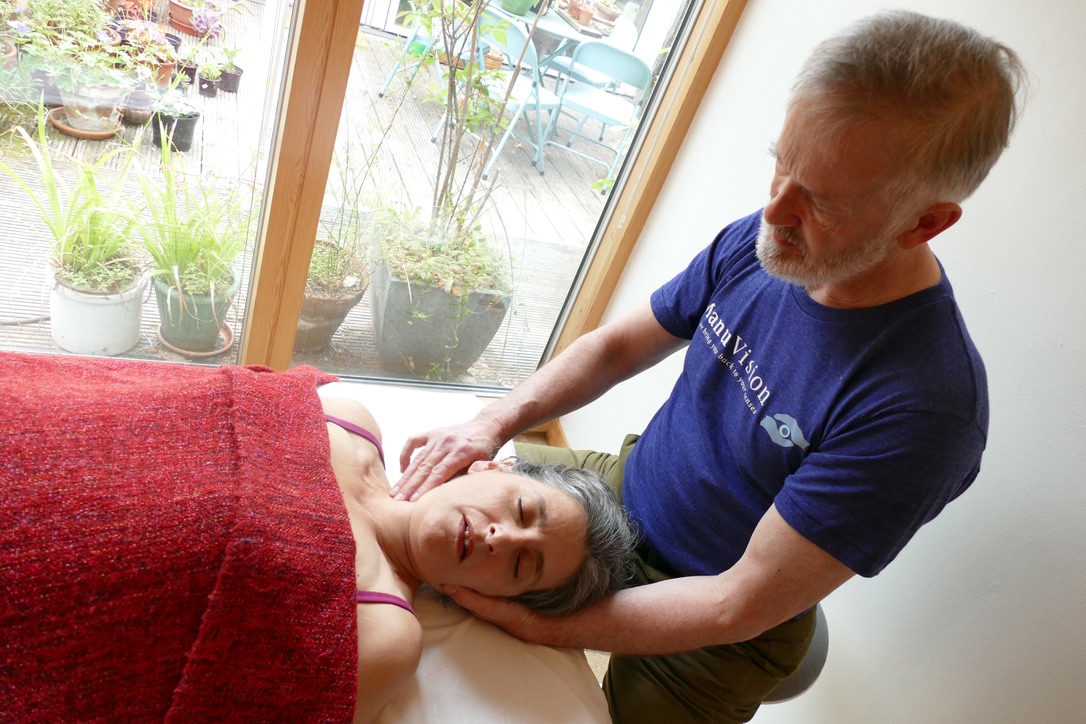
Sessions begin with a discussion with the therapist, in which the client shares his or her reasons for coming and other relevant information. During this discussion the therapist explains how our nervous system responds to receiving shocks and traumas and how the treatment can help to restore its correct functioning.
The client is then asked to lie on the back on a massage table. The therapist will ‘see’ with his hands and eyes what the body ‘tells’. This feedback guides the therapist, and he will throughout the treatment return to this kind of seeing.
The client will be guided in how to relate to their breathing, any pain and in ‘letting go’. In this process the client is likely to experience a deeper connection with the body and the feelings, a deeper breathing and a sense of lightness.
As tensions release and thoughts recalibrate, an experience of ‘opening’ is felt as the nervous system is restored to correct functioning, allowing the body’s inherent healing force to come into play.
Before, during and after the treatment you are welcome to ask questions.
You can be fully dressed if you like.
But we recommend for men to be dressed in underpants and women pants and a bra or top.
You will be covered with a blanket.


